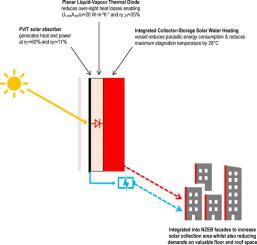当前位置:
X-MOL 学术
›
Sol. Energy
›
论文详情
Our official English website, www.x-mol.net, welcomes your feedback! (Note: you will need to create a separate account there.)
BIPV/T facades – A new opportunity for integrated collector-storage solar water heaters? Part 1: State-of-the-art, theory and potential
Solar Energy ( IF 6.7 ) Pub Date : 2020-09-01 , DOI: 10.1016/j.solener.2020.06.025 Adrian Pugsley , Aggelos Zacharopoulos , Jayanta Deb Mondol , Mervyn Smyth
Solar Energy ( IF 6.7 ) Pub Date : 2020-09-01 , DOI: 10.1016/j.solener.2020.06.025 Adrian Pugsley , Aggelos Zacharopoulos , Jayanta Deb Mondol , Mervyn Smyth

|
Abstract Building Integrated Photovoltaic Thermal (BIPV/T) systems are promising solutions for serving local electricity and heat demands in Net Zero Energy Buildings (NZEB). Despite BIPV/T offering clear energetic and space saving advantages compared to separate BIPV and solar thermal, overheating occurs when no thermal demand exists, resulting in reduced yields, stagnation damage, and excessive fluid pressures. Whilst continuous fluid flows mitigate overheating, corresponding parasitic demands and space requirements are significant (pumps, large storage tanks or heat rejection equipment). This two-part study examines an alternative approach to BIPV/T, addressing overheating by combining BIPV and Integrated Collector-Storage Solar Water Heater (ICSSWH) concepts. Solar heating capabilities of ICSSWH collectors are well established and their overnight heat loss characteristics provide passive overheating control. BIPV-ICSSWH approaches have yet to be investigated extensively. This paper (Part 1 of 2) reviews state-of-the-art and performance benchmarks in BIPV/T and ICSSWH; proposes new performance metrics enabling fairer comparisons; and develops a heat transfer model for BIPV-ICSSWH facade elements employing Planar Liquid-Vapour Thermal Diodes (PLVTD) to regulate absorber temperatures and heat losses. Multi-day solar thermal collection, photovoltaic generation, and overnight heat retention behaviours are simulated in different climates. The modelling results (experimentally validated in Part 2 of 2) suggests BIPV-PLVTD-ICSSWHs with single transparent covers and ς ≈ 90% PLVTD diodicity achieve η T , c o l ≈ 60% solar thermal efficiency at N ≈ 0.035m2K·W−1, PV/T performance ratio PRT3 ≈ 75%, and heat loss coefficient Ur,sysAsys/u ≈ 20 W·m−3K−1. The novel BIPV-PLVTD-ICSSWH approach can reduce maximum stagnation by 20 °C compared to conventional BIPV/T and therefore support NZEB realisation during global efforts to tackle the climate crisis.
中文翻译:

BIPV/T 外墙 – 集成集热存储太阳能热水器的新机会?第 1 部分:最新技术、理论和潜力
摘要 建筑集成光伏热能 (BIPV/T) 系统是满足净零能耗建筑 (NZEB) 当地电力和热能需求的有前途的解决方案。尽管与单独的 BIPV 和太阳能热能相比,BIPV/T 提供了明显的能量和节省空间的优势,但在不存在热需求时会发生过热,导致产量降低、停滞损坏和过高的流体压力。虽然连续的流体流动可以减轻过热,但相应的寄生需求和空间要求也很重要(泵、大型储罐或排热设备)。这项由两部分组成的研究探讨了 BIPV/T 的替代方法,通过将 BIPV 和集成集热器-存储太阳能热水器 (ICSSWH) 概念相结合来解决过热问题。ICSSWH 集热器的太阳能加热能力已经确立,其夜间热损失特性提供被动过热控制。BIPV-ICSSWH 方法尚未得到广泛研究。本文(第 1 部分,共 2 部分)回顾了 BIPV/T 和 ICSSWH 中的最新技术和性能基准;提出新的绩效指标,以便进行更公平的比较;并开发了 BIPV-ICSSWH 立面元件的传热模型,采用平面液汽热二极管 (PLVTD) 来调节吸收器温度和热损失。在不同气候下模拟多日太阳能集热、光伏发电和过夜保温行为。建模结果(在第 2 部分的第 2 部分中进行了实验验证)表明 BIPV-PLVTD-ICSSWH 具有单个透明覆盖物且 ς ≈ 90% PLVTD 二元性达到 η T ,col ≈ 60% 太阳能热效率,N ≈ 0.035m2K·W−1,PV/T 性能比 PRT3 ≈ 75%,热损失系数 Ur,sysAsys/u ≈ 20 W·m−3K−1。与传统的 BIPV/T 相比,新型 BIPV-PLVTD-ICSSWH 方法可以将最大停滞降低 20°C,因此支持在全球应对气候危机的努力中实现 NZEB。
更新日期:2020-09-01
中文翻译:

BIPV/T 外墙 – 集成集热存储太阳能热水器的新机会?第 1 部分:最新技术、理论和潜力
摘要 建筑集成光伏热能 (BIPV/T) 系统是满足净零能耗建筑 (NZEB) 当地电力和热能需求的有前途的解决方案。尽管与单独的 BIPV 和太阳能热能相比,BIPV/T 提供了明显的能量和节省空间的优势,但在不存在热需求时会发生过热,导致产量降低、停滞损坏和过高的流体压力。虽然连续的流体流动可以减轻过热,但相应的寄生需求和空间要求也很重要(泵、大型储罐或排热设备)。这项由两部分组成的研究探讨了 BIPV/T 的替代方法,通过将 BIPV 和集成集热器-存储太阳能热水器 (ICSSWH) 概念相结合来解决过热问题。ICSSWH 集热器的太阳能加热能力已经确立,其夜间热损失特性提供被动过热控制。BIPV-ICSSWH 方法尚未得到广泛研究。本文(第 1 部分,共 2 部分)回顾了 BIPV/T 和 ICSSWH 中的最新技术和性能基准;提出新的绩效指标,以便进行更公平的比较;并开发了 BIPV-ICSSWH 立面元件的传热模型,采用平面液汽热二极管 (PLVTD) 来调节吸收器温度和热损失。在不同气候下模拟多日太阳能集热、光伏发电和过夜保温行为。建模结果(在第 2 部分的第 2 部分中进行了实验验证)表明 BIPV-PLVTD-ICSSWH 具有单个透明覆盖物且 ς ≈ 90% PLVTD 二元性达到 η T ,col ≈ 60% 太阳能热效率,N ≈ 0.035m2K·W−1,PV/T 性能比 PRT3 ≈ 75%,热损失系数 Ur,sysAsys/u ≈ 20 W·m−3K−1。与传统的 BIPV/T 相比,新型 BIPV-PLVTD-ICSSWH 方法可以将最大停滞降低 20°C,因此支持在全球应对气候危机的努力中实现 NZEB。



























 京公网安备 11010802027423号
京公网安备 11010802027423号